Please share with your friends!
Montessori Language curriculum and beginning steps
So you’ve set up some areas in your home that are Montessori friendly. You set up a Montessori Toy Shelf and you included a kitchen tower for your child. Now you ask yourself the question, how can I make sure I’m incorporating some Montessori Language curriculum in my home? You know that it’s important to get your older toddler or young preschooler ready for reading and writing. You’re ready to make this next step.
You’re already doing so much language with your little one: reading stories together, naming objects around your home or outside, and singing songs. Everything you do together incorporates language development in some way; even just talking to your child! But what are some more activities you could do to extend this further?
Oral Language Activities
In the Montessori Language Curriculum for Early Childhood, ages two and a half to six, we start with Oral Language activities. In this section of activities, we explore the spoken word with visuals such as pictures, objects, and books. Your child practices listening skills while developing a love for books and stories.
Here are the 5 Montessori Language Curriculum Activities to get your child started!
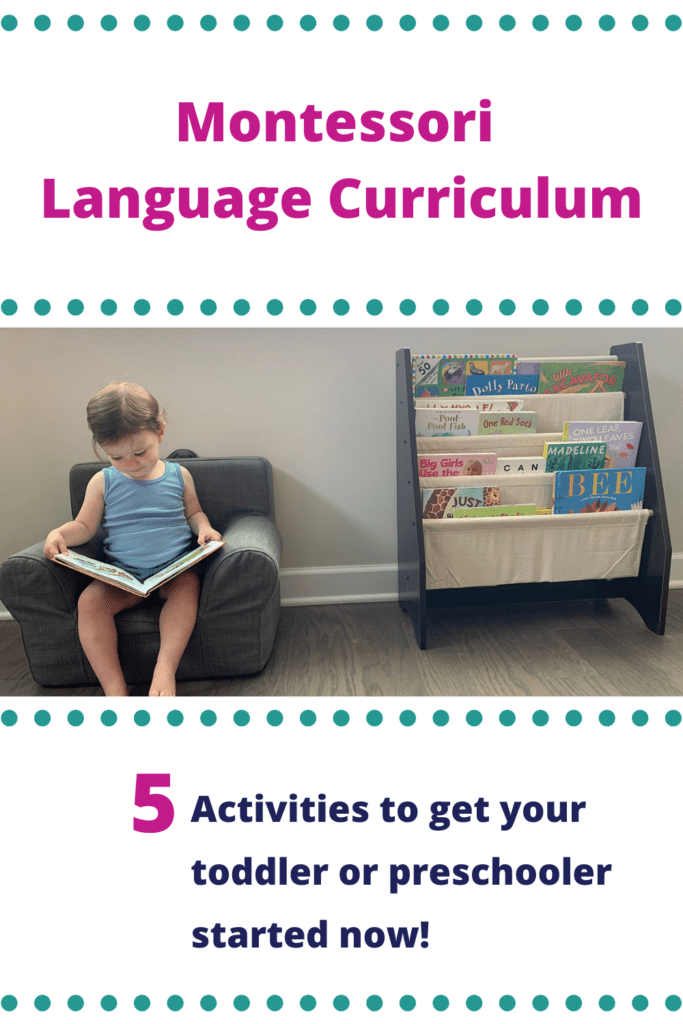
1. Book Corner
You already have a collection of books for your child. Get started with creating a book corner in your home! Your book corner should be attractive and homey. Displaying the books on a beautiful shelf with the book covers facing forward will allow the books to really call to your child.
- Be sure to put just enough books on the shelf so it doesn’t look too cluttered.
- Rotate the books frequently, about one to three weeks.
- Choose books that are appealing to your child with attractive illustrations.
- Find books that relate to what you’re working on right now and what your child is interested in.
- Check out books from the library on a regular basis and join a kids’ book club.
- Include a child-sized comfy chair or sofa near your bookshelf so that your little one feels relaxed while looking at books.
- Optional: set up a small table with a small vase and a flower and anything else that your child loves.
The most important thing is that you’re setting up a special place for books. You want your child to love books and understand that books are special. You want your child’s experience with books to be pleasant and positive.
Helpful Tip: Find spontaneous times throughout the day to read all kinds of books and literature, even chapter books and novels! Model for your child that you enjoy books, too! If you show your child that you love books, that books are special, and that you respect books, your child will do the same.
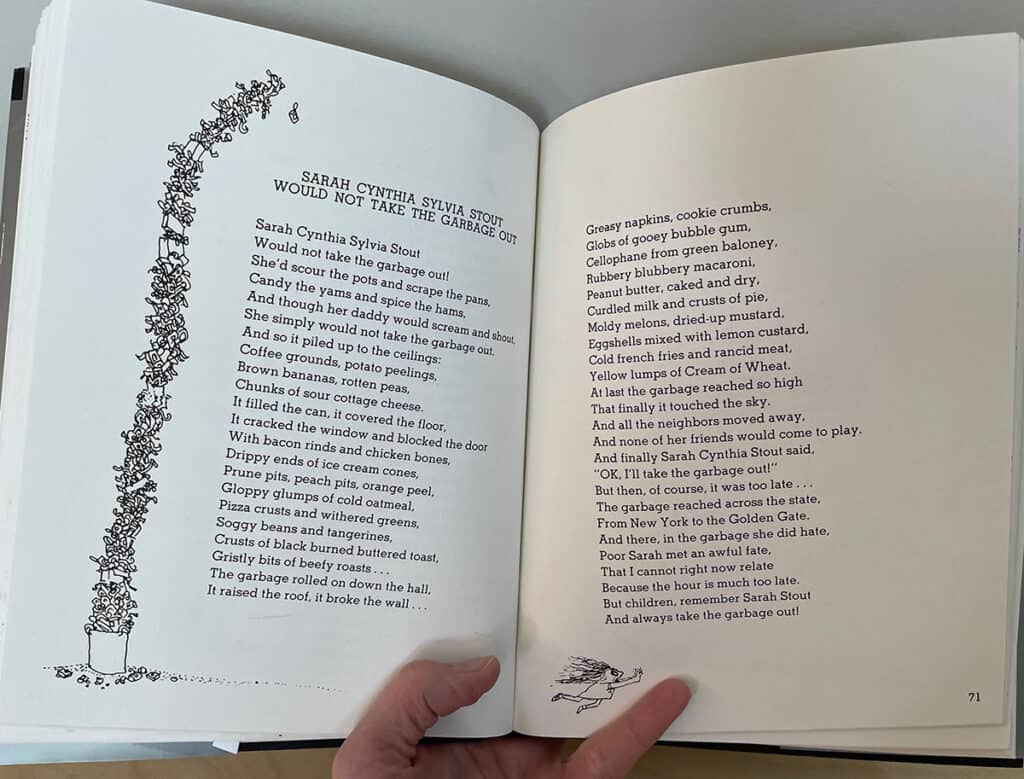
2. Rhyming
Rhyming is so important for language development for young children. You’re probably doing a lot of rhyming already. For instance, you’re singing songs that rhyme and reading books that rhyme.
To extend this further, here are more ways you can incorporate rhyming in your day:
- Poetry has a natural musical cadence to it. It’s not important that your child understands every word or the meaning of the poems. It’s important for your child to hear the words that sound the same and the rhythmic quality of the poems.
- We love the poetry book, Where the Sidewalk Ends, by Shel Silverstein (affiliate link). The poems are very funny and make us laugh! Our favorite is Sarah Sylvia Cynthia Stout Would Not Take the Garbage Out.
- Nursery Rhymes are classic short stories/songs that are familiar and have rhyming words and a musical rhythm to them. For example:
- Jack and Jill
- Baa Baa Black Sheep
- Humpty Dumpty
- Hey, Diddle Diddle
- Finger Plays are classic children’s songs where you use hand movements with singing, such as:
- The Itsy Bitsy Spider
- Two Little Blackbirds
- Five Little Monkeys
- Open and Shut Them
Talk to your child about rhyming words. Say, “rhyming words sound the same at the end.”
Rhyming is an important skill for young children to learn. In the Montessori Language Curriculum, the matching rhyming objects lesson comes just before exploring with sounds of words. So your child will continue to explore rhyming.
Rhyming activities prepare your child for auditory discrimination and activities that help develop phonemic awareness, or being able to identify and manipulate individual sounds of spoken words.
To learn more about Rhyming and Poetry, check out my other posts that go into greater detail:
- Our 8 Favorite Poetry For Children Books That Make Us Happy
- Try This Cute Recycled Owl Craft And Make A Rhyme Come Alive
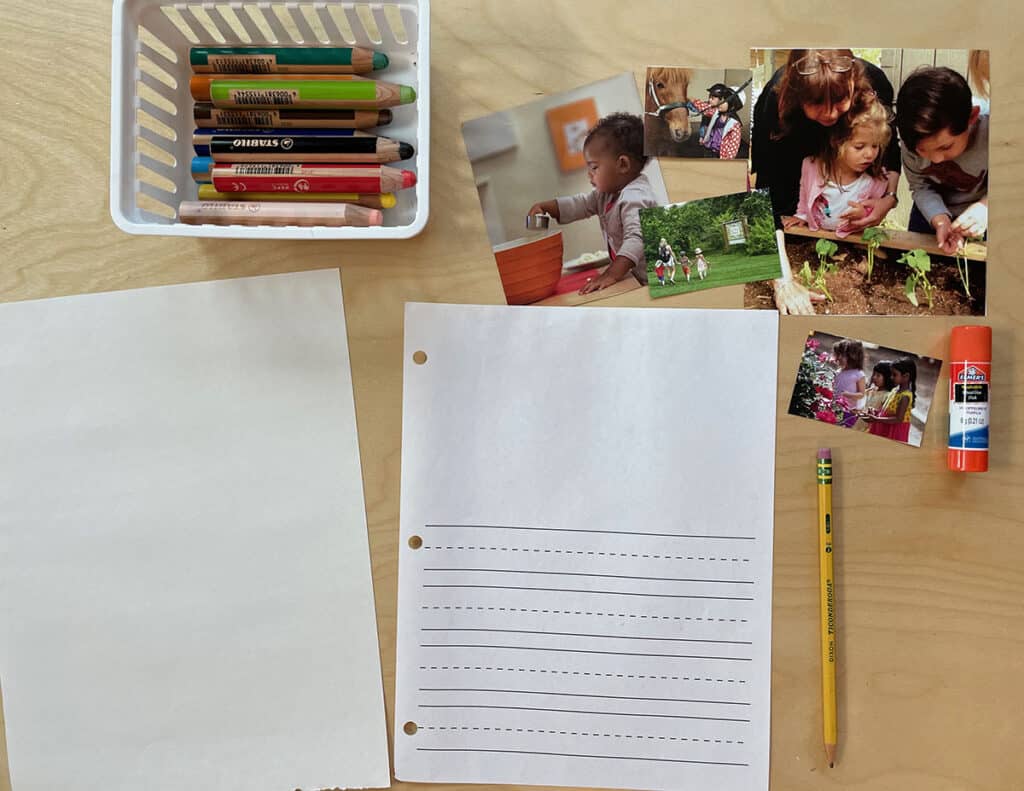
3. Storytelling with pictures and art
When I was a teacher in the Montessori classroom, Picture Story was one of the kids’ favorite activities. We combine art with language. At the easel, a child draws or paints a picture and brings it to the teacher. The child tells the teacher the story about what’s in the picture and the teacher writes down the story with pencil at the bottom of the paper.
To learn how to create a collection of your child’s stories, check out my other blog post about creating a Storybook journal!
The youngest three-year-olds usually label parts of the drawing and the teacher writes down the labels next to the little pictures. This is normal. With more practice, the little ones start to tell a more complete story in sentences.
You could also collect pictures from magazines or print out pictures/photos found online for this activity. If your child’s not ready to draw pictures or doesn’t want to, she can pick out a picture and tell you a story about it and you can write it down.
You could also used lined paper to model handwriting on the lines, for your child to observe.
This activity helps your child to understand that the printed word and oral communication are connected.
To learn more about Picture Story, I go into greater detail in these blog posts:
- Create 4 Simple and Playful Storytelling for Kids Activities
- Storybook Journal for Preschoolers: A Super Easy Way to Connect Spoken and Written Language
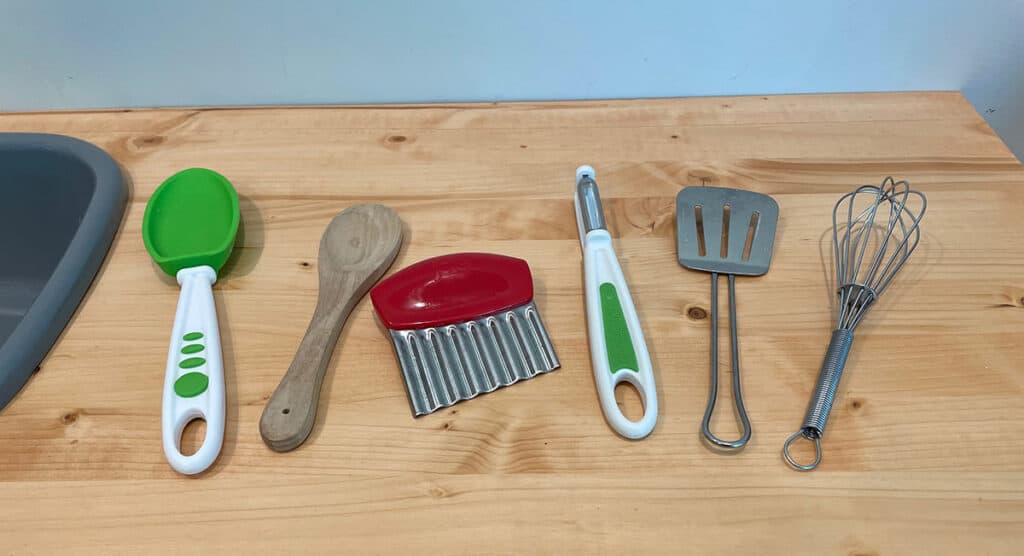
4. Classifying objects around the house
Before you start a collection of tiny language objects or pictures for your child to explore with, such as matching and go-togethers, you can start pointing out things around the house that go together and naming them. You can also do this with things outside, on a car ride, going to the playground, or going on a trip.
Classify the objects, meaning, explain to your child that all of these things go together, and say what category they all fall under. For example:
- Kitchen Utensils:
- Spatula
- Whisk
- Mixing spoon
- Carrot peeler
- Garden Tools:
- Garden shovel
- Rake
- Gardening fork
- Gardening gloves
- While grocery shopping you can categorize Fruits or Vegetables:
- Banana, apple, grapes, strawberries, orange
- carrot, broccoli, asparagus, potato, green beans
This activity is great for vocabulary enrichment and understanding that things go together. The ideas for categories are endless! Here are more ideas you can do around the home:
- Rooms and furniture
- Laundry and clothes
- Bathroom items
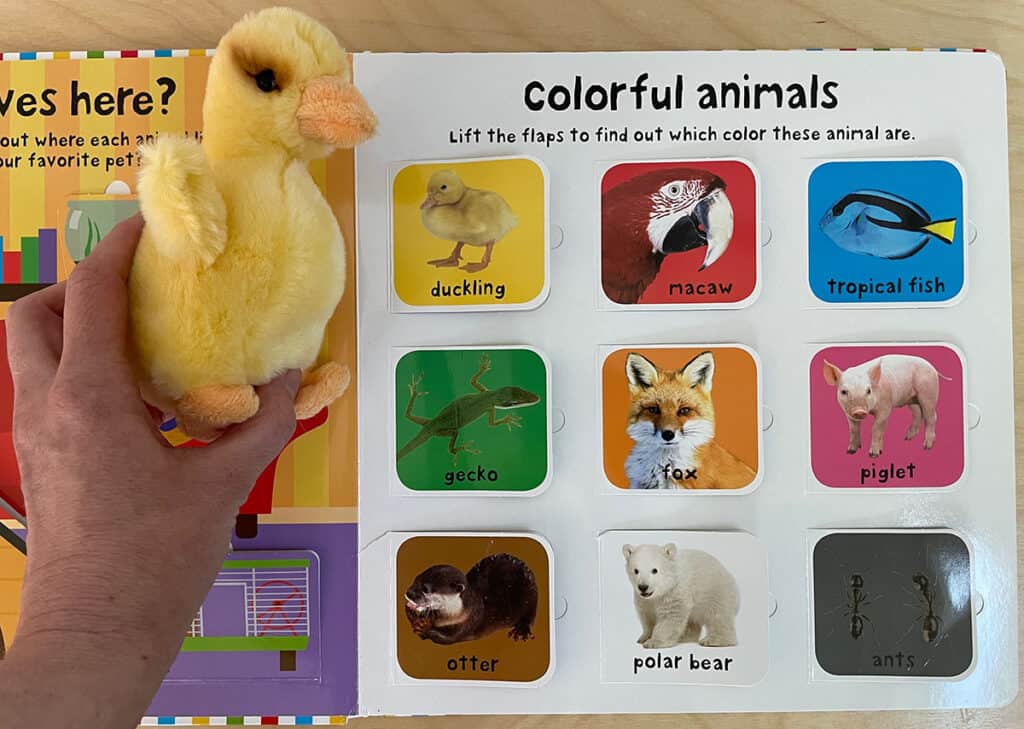
5. Matching objects and pictures
You can also match things you have around the house. Walk around the house and go on a little scavenger hunt together! Get creative with what you have. For example:
- Match fruits you have in the kitchen
- Match eating utensils (forks, spoons), plates, bowls, and cups
- Match pairs of things: socks, shoes, gloves, outfits
You can also match objects to pictures you have in books. Pick out some books on the shelf and see if you can find matching objects in the room or outside. For example, you could have a book about farm animals, as well as a collection of farm animal figures or toys. You can go through the book together and match the animals.
Matching objects and pictures around the house is a fun activity you can do right now before you start collecting small matching language objects and matching cards. Matching activities are great for strengthening visual discrimination skills and for vocabulary enrichment.
To learn more about object to picture matching, go to my blog post, Fun Object-To-Picture Matching Activities (4 Simple Ideas)
Concluding Thoughts
You are most likely doing a lot of these activities already in some way with your child every day. This is wonderful! Incorporating these activities in purposeful ways will help to extend the benefits further.
Oral language activities are an important first step in the Montessori Language curriculum. There is so much you can do with your older toddler or young preschooler at home. I hope this post has helped and inspired you to try some activities at home or when you’re out and about!
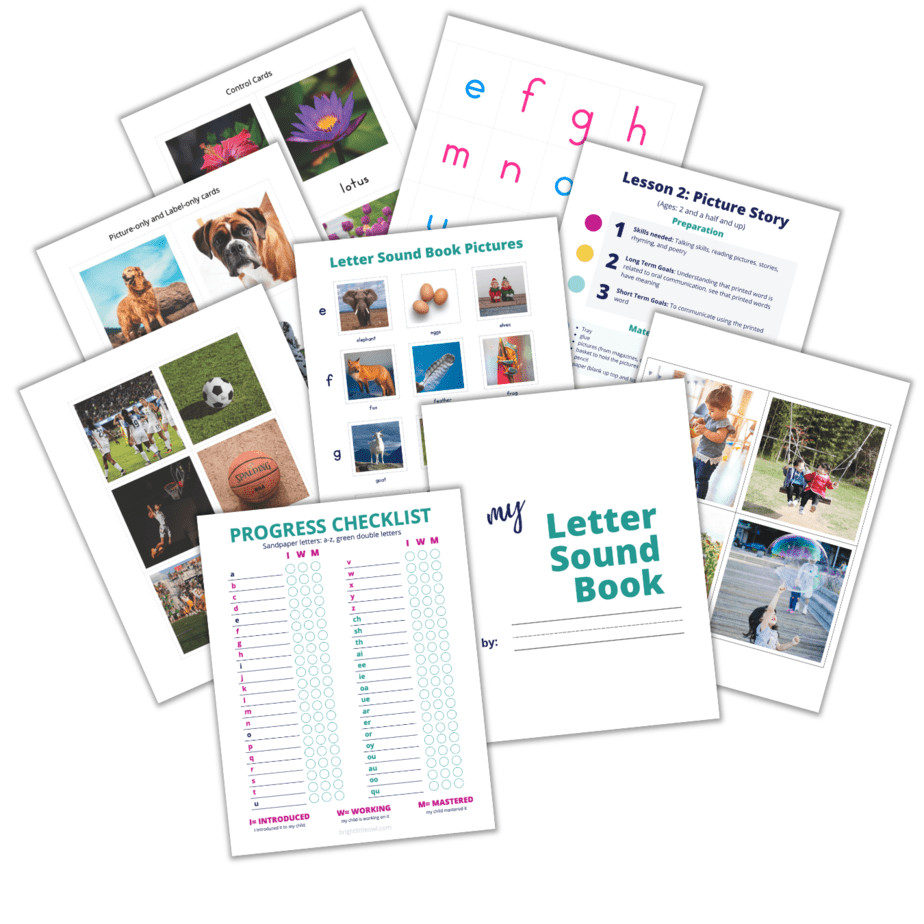

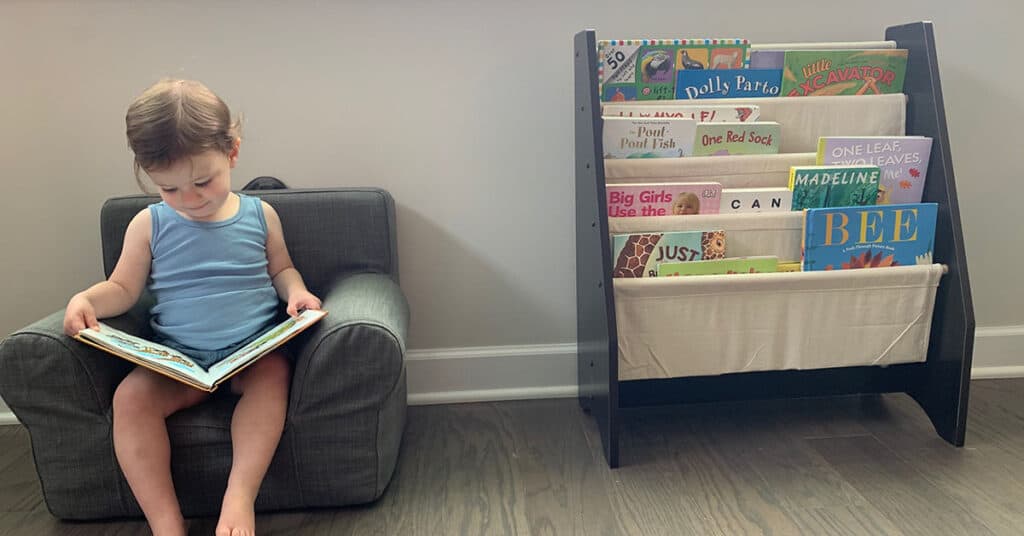
Pingback: Storybook Journal for Preschoolers: A Super Easy Way to Connect Spoken and Written Language
Pingback: Montessori 3-Part Cards and Language Development: First, Get Your Hands Dirty!
Pingback: Color Mixing Lesson And Coffee Filter Flower Craft - Bright Little Owl